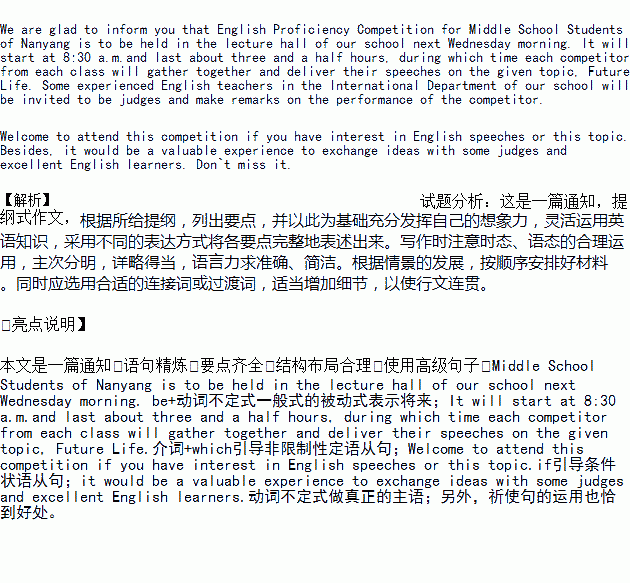ΧβΡΩΡΎ»ί
ΦΌΕ®Ρψ «άνΜΣ,ΓΑΡœ―τ –÷–―ß…ζ”Δ”οΡήΝΠΨΚ»ϋΓ±ΫΪ‘ΎΡψ–ΘΨΌ––,«κΗυΨί“‘œ¬“ΣΒψ,“‘―ß…ζΜαΒΡΟϊ“ε,Ηχ»ΪΧε―ß…ζ–¥“ΜΤΣΆ®÷ΣΓΘ
1. ΨΚ»ϋΡΎ»ίΘΚΙΊ”ΎΓΑΈ¥ά¥…ζΜνΓ±ΒΡ―ίΫ≤
2. ±ΦδΚΆΒΊΒψΘΚœ¬÷ή»ΐ…œΈγ8ΘΚ30-12ΘΚ00ΘΜ±®ΗφΧϋ
3. ―Γ ÷ΘΚΟΩΑύ“ΜΟϊ≤Έ»ϋ―Γ ÷
4. ΤάΈ·ΘΚΙζΦ ≤Ω”Δ”οΫΧ Π
5. “Σ«σΘΚΜΕ”≠≤Έ”κ,ΜΐΦΪΫΜΝς
ΉΔ“βΘΚ
1. ¥ ΐΘΚ100Ήσ”“ΘΜ
2. Ω… Β±‘ωΦ”œΗΫΎ,“‘ Ι––ΈΡΝ§ΙαΓΘ
Notice
We are glad to inform you that_____________________________________________________________
____________________________________________________________________________________________
____________________________________________________________________________________________
____________________________________________________________________________________________
____________________________________________________________________________________________
____________________________________________________________________________________________
____________________________________________________________________________________________
____________________________________________________________________________________________
__________________________________________________
 –¬ΩΈ±ξΩλά÷Χα”≈ νΦΌΉς“Β…¬Ές¬Ο”Έ≥ωΑφ…γœΒΝ–¥πΑΗ
–¬ΩΈ±ξΩλά÷Χα”≈ νΦΌΉς“Β…¬Ές¬Ο”Έ≥ωΑφ…γœΒΝ–¥πΑΗ νΦΌœΈΫ”≈ύ”≈ΫΧ≤Ρ’ψΫ≠ΙΛ…Χ¥σ―ß≥ωΑφ…γœΒΝ–¥πΑΗ
νΦΌœΈΫ”≈ύ”≈ΫΧ≤Ρ’ψΫ≠ΙΛ…Χ¥σ―ß≥ωΑφ…γœΒΝ–¥πΑΗ
